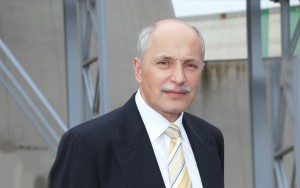 For years Kaliningrad has been allowed to decay as a forgotten Russian enclave surrounded by Europe. But now a movement is afoot to rebuild the city center. The castle too may soon dominate the skyline once again.
For years Kaliningrad has been allowed to decay as a forgotten Russian enclave surrounded by Europe. But now a movement is afoot to rebuild the city center. The castle too may soon dominate the skyline once again.
The city center of Kaliningrad is not a pretty site.
Shoddy concrete housing blocks constructed by the late communist regime stand next to rusted water fountains and apartment blocks from the Third Reich. A 20-story Communist Party fortress ( the "House of the Soviets") rises up in the center. The building is a ruin.
It's not uncommon for elderly East Prussians ( having arrived in a tour boat in the nearby port of Pillau) to break into tears when they see to what architectural depths their city of birth has sunk to. The destruction visited on the former pearl on the Pregel River by the bombs of World War II was immense - matched by hardly any other European city. Indeed, Kaliningrad, once known by its German name Königsberg, became a symbol not just of loss, but also of the destruction of homeland.
Some 30 divisions and two air fleets of the Red Army attacked the surrounded city during the final battle in April 1945. They fired at the city from thousands of barrels for days, without interruption.
It's time to turn the tide.
No one here wants to run from the city's Prussian German legacy. On the contrary. To restore a sense of urbanity to the ravaged city center ( further wrecked by the Soviets) is to go retro.
The cathedral, which was damaged during the war, has already been rebuilt. The "Fishermen`s Village" - a group of old half-timbered houses and 18th century-style warehouses complete with pinnacled roofs - is currently taking shape right next door, on the banks of the Pregel.
But the city is presently the site of another, far more ambitious project - that of rebuilding its castle. The defensive fortress was built by the Teutonic Order in 1255 as a jumping off point for crusaders heading east - a military stronghold in the midst of a pagan wilderness, built on the ruins of the freshly conquered Baltic fortress
Twangste.

The old Prussian center was considered a "hornet's nest of militarism and fascism" in the jargon of the communist rulers. In 1969, then party leader Leonid Brezhnev had the still impressive castle ruins blown up and the rubble cleared away with bulldozers, right down to the foundations.
That kind of animosity is hardly to be found in Kaliningrad today. An isolated region, northern East Prussia led an impoverished and shadowy existence in the Soviet empire for decades, but now a fresh wind is blowing. Petro-billionaires and oligarchs from Moscow have discovered the region for themselves and they're bringing plenty of money, much of it of dubious origin, into the area.
Economic growth could be one reason. For the third year in a row, the enclave by the Baltic Sea has seen GDP jump by at least 10 percent. Bars, restaurants and hotels are springing up out of the ground and the city now has the second highest concentration of cars in the country. The old Amber Coast has become Russia's new place in the sun.
Russian prime minister Vladimir Putin likes the idea of bringing back the Prussian fortress. On a visit to the region, he promised the equivalent of $50 million from the state treasury. Putin, of course, also has an interest in a resurgence of Kaliningrad. His family is currently building a villa in the area, on the Courland Spit which separates the nearby Courland Lagoon from the Baltic Sea.

But there's still plenty of work to do. The crusader fortress took on enormous proportions over the centuries with the inner courtyard stretching for fully 105 meters (328 feet). The castle's tower "Bergfried," which was more than 80 meters (263 feet) tall. The west wing contained the Moscovite Hall with its collection of trophies; a mechanical elevator transported wine barrels into the cellar.

Just how sumptuous the interior was can be seen in paintings showing the 1701 coronation of Prussia's first king, Frederick. Apparitors in festive dress heralded the grand event, followed by 24 trumpeters, drummers and 60 aristocrats. It was the beginning of the dream of world power.
All this finery went up in flames in August, 1944. The British Air Force sent two waves of more than 800 bombers over the city. Newly developed fire bombs were dropped from bomb bays - and 48 percent of all buildings were damaged or destroyed in the resulting inferno. The legendary Amber Room - displayed as German war booty in the castle between 1942 and 1944 - disappeared without a trace.
Only recently has an exploration of the basement vault ( financed by DER SPIEGEL) yielded new findings. Researchers have discovered old wine bottles and a collection of amulets. The remains of the castle's heating system were also found, as was a secret underground tunnel.
Despite the near total loss of the original building material, an accurate reconstruction is possible. The castle was mainly built from bricks and it was plastered, this makes elaborate stonecutting work largely unnecessary.
The reconstruction of the Prussian palaces in Potsdam and Berlin ( also blown up) has been stalled for years, partly because the effete elite considers the imitation of historical buildings "kitsch."

The castle must be rebuilt. We estimate it will cost $100 million.
It is essential for the city to be rebuilt. It is the greatest of shames that such a beautiful city was bulldozed by malicious individuals. I feel that the rebuilding of Konigsberg would give back to the city its cultural heart which was sadly taken away.










 The old Prussian center was considered a "hornet's nest of militarism and fascism" in the jargon of the communist rulers. In 1969, then party leader Leonid Brezhnev had the still impressive castle ruins blown up and the rubble cleared away with bulldozers, right down to the foundations.
The old Prussian center was considered a "hornet's nest of militarism and fascism" in the jargon of the communist rulers. In 1969, then party leader Leonid Brezhnev had the still impressive castle ruins blown up and the rubble cleared away with bulldozers, right down to the foundations. But there's still plenty of work to do. The crusader fortress took on enormous proportions over the centuries with the inner courtyard stretching for fully 105 meters (328 feet). The castle's tower "Bergfried," which was more than 80 meters (263 feet) tall. The west wing contained the Moscovite Hall with its collection of trophies; a mechanical elevator transported wine barrels into the cellar.
But there's still plenty of work to do. The crusader fortress took on enormous proportions over the centuries with the inner courtyard stretching for fully 105 meters (328 feet). The castle's tower "Bergfried," which was more than 80 meters (263 feet) tall. The west wing contained the Moscovite Hall with its collection of trophies; a mechanical elevator transported wine barrels into the cellar. Just how sumptuous the interior was can be seen in paintings showing the 1701 coronation of Prussia's first king, Frederick. Apparitors in festive dress heralded the grand event, followed by 24 trumpeters, drummers and 60 aristocrats. It was the beginning of the dream of world power.
Just how sumptuous the interior was can be seen in paintings showing the 1701 coronation of Prussia's first king, Frederick. Apparitors in festive dress heralded the grand event, followed by 24 trumpeters, drummers and 60 aristocrats. It was the beginning of the dream of world power.




